Alsatian vs Pakistani Community Comparison
COMPARE
Alsatian
Pakistani
Social Comparison
Social Comparison
Alsatians
Pakistanis
4,075
SOCIAL INDEX
38.3/ 100
SOCIAL RATING
206th/ 347
SOCIAL RANK
8,084
SOCIAL INDEX
78.3/ 100
SOCIAL RATING
88th/ 347
SOCIAL RANK
Pakistani Integration in Alsatian Communities
The statistical analysis conducted on geographies consisting of 73,429,967 people shows a significant positive correlation between the proportion of Pakistanis within Alsatian communities in the United States with a correlation coefficient (R) of 0.638. On average, for every 1% (one percent) increase in Alsatians within a typical geography, there is an increase of 0.633% in Pakistanis. To illustrate, in a geography comprising of 100,000 individuals, a rise of 1,000 Alsatians corresponds to an increase of 633.1 Pakistanis.
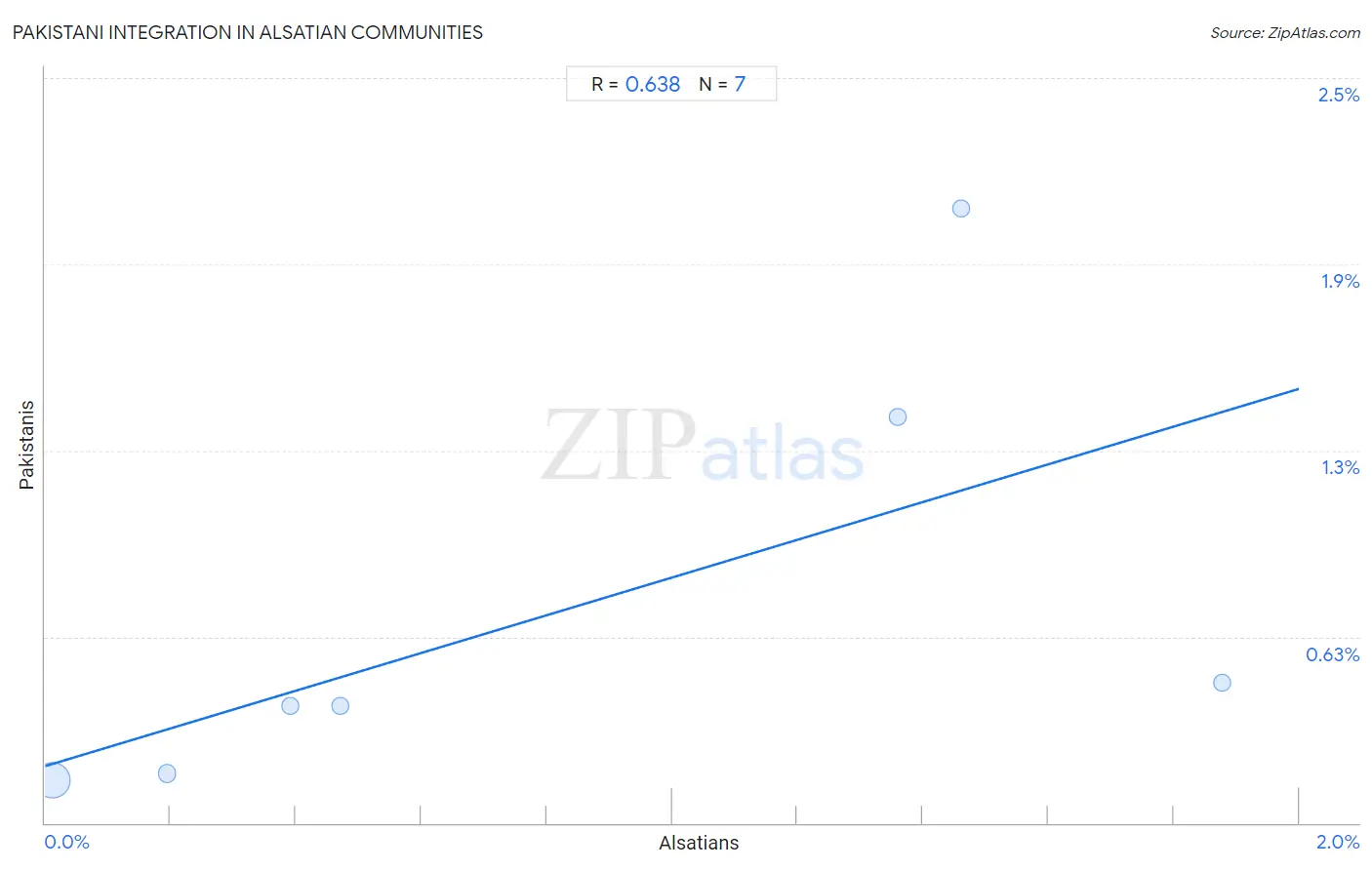
Alsatian vs Pakistani Income
When considering income, the most significant differences between Alsatian and Pakistani communities in the United States are seen in householder income under 25 years ($49,267 compared to $53,325, a difference of 8.2%), wage/income gap (24.7% compared to 26.1%, a difference of 5.6%), and median household income ($85,053 compared to $89,638, a difference of 5.4%). Conversely, both communities are more comparable in terms of median female earnings ($40,060 compared to $40,596, a difference of 1.3%), median male earnings ($55,380 compared to $56,719, a difference of 2.4%), and median earnings ($47,023 compared to $48,254, a difference of 2.6%).

| Income Metric | Alsatian | Pakistani |
| Per Capita Income | Exceptional $47,284 | Excellent $45,587 |
| Median Family Income | Average $103,010 | Exceptional $107,390 |
| Median Household Income | Average $85,053 | Exceptional $89,638 |
| Median Earnings | Good $47,023 | Exceptional $48,254 |
| Median Male Earnings | Good $55,380 | Excellent $56,719 |
| Median Female Earnings | Good $40,060 | Excellent $40,596 |
| Householder Age | Under 25 years | Tragic $49,267 | Exceptional $53,325 |
| Householder Age | 25 - 44 years | Average $95,059 | Excellent $98,401 |
| Householder Age | 45 - 64 years | Average $100,435 | Exceptional $105,317 |
| Householder Age | Over 65 years | Good $61,797 | Exceptional $63,844 |
| Wage/Income Gap | Exceptional 24.7% | Fair 26.1% |
Alsatian vs Pakistani Poverty
When considering poverty, the most significant differences between Alsatian and Pakistani communities in the United States are seen in child poverty among boys under 16 (19.1% compared to 15.1%, a difference of 26.3%), child poverty under the age of 16 (18.6% compared to 15.0%, a difference of 24.0%), and single male poverty (15.2% compared to 12.4%, a difference of 23.1%). Conversely, both communities are more comparable in terms of seniors poverty over the age of 75 (12.6% compared to 11.8%, a difference of 6.7%), seniors poverty over the age of 65 (11.3% compared to 10.3%, a difference of 9.0%), and receiving food stamps (11.4% compared to 10.4%, a difference of 9.5%).
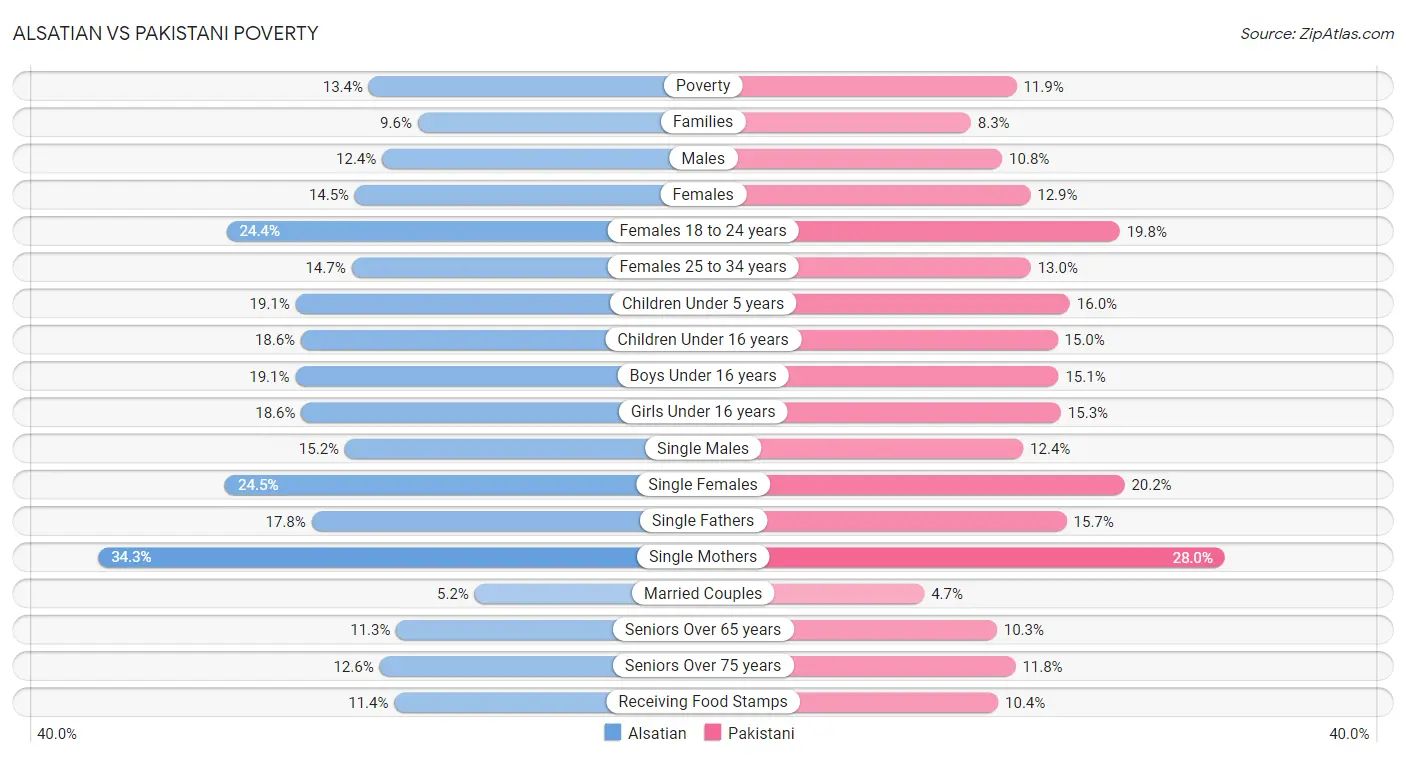
| Poverty Metric | Alsatian | Pakistani |
| Poverty | Tragic 13.4% | Excellent 11.9% |
| Families | Poor 9.6% | Exceptional 8.3% |
| Males | Tragic 12.4% | Excellent 10.8% |
| Females | Tragic 14.5% | Excellent 12.9% |
| Females 18 to 24 years | Tragic 24.4% | Good 19.8% |
| Females 25 to 34 years | Tragic 14.7% | Excellent 13.0% |
| Children Under 5 years | Tragic 19.1% | Exceptional 16.0% |
| Children Under 16 years | Tragic 18.6% | Exceptional 15.0% |
| Boys Under 16 years | Tragic 19.1% | Exceptional 15.1% |
| Girls Under 16 years | Tragic 18.6% | Exceptional 15.3% |
| Single Males | Tragic 15.2% | Exceptional 12.4% |
| Single Females | Tragic 24.5% | Exceptional 20.2% |
| Single Fathers | Tragic 17.8% | Exceptional 15.7% |
| Single Mothers | Tragic 34.3% | Exceptional 28.0% |
| Married Couples | Average 5.2% | Exceptional 4.7% |
| Seniors Over 65 years | Fair 11.3% | Exceptional 10.3% |
| Seniors Over 75 years | Poor 12.6% | Excellent 11.8% |
| Receiving Food Stamps | Good 11.4% | Exceptional 10.4% |
Alsatian vs Pakistani Unemployment
When considering unemployment, the most significant differences between Alsatian and Pakistani communities in the United States are seen in unemployment among seniors over 75 years (6.1% compared to 8.9%, a difference of 45.1%), unemployment among ages 60 to 64 years (5.8% compared to 4.8%, a difference of 19.9%), and unemployment among ages 16 to 19 years (20.5% compared to 17.2%, a difference of 19.2%). Conversely, both communities are more comparable in terms of unemployment among seniors over 65 years (5.2% compared to 5.1%, a difference of 2.6%), unemployment among women with children under 6 years (7.1% compared to 7.3%, a difference of 3.0%), and unemployment (5.3% compared to 5.1%, a difference of 3.6%).
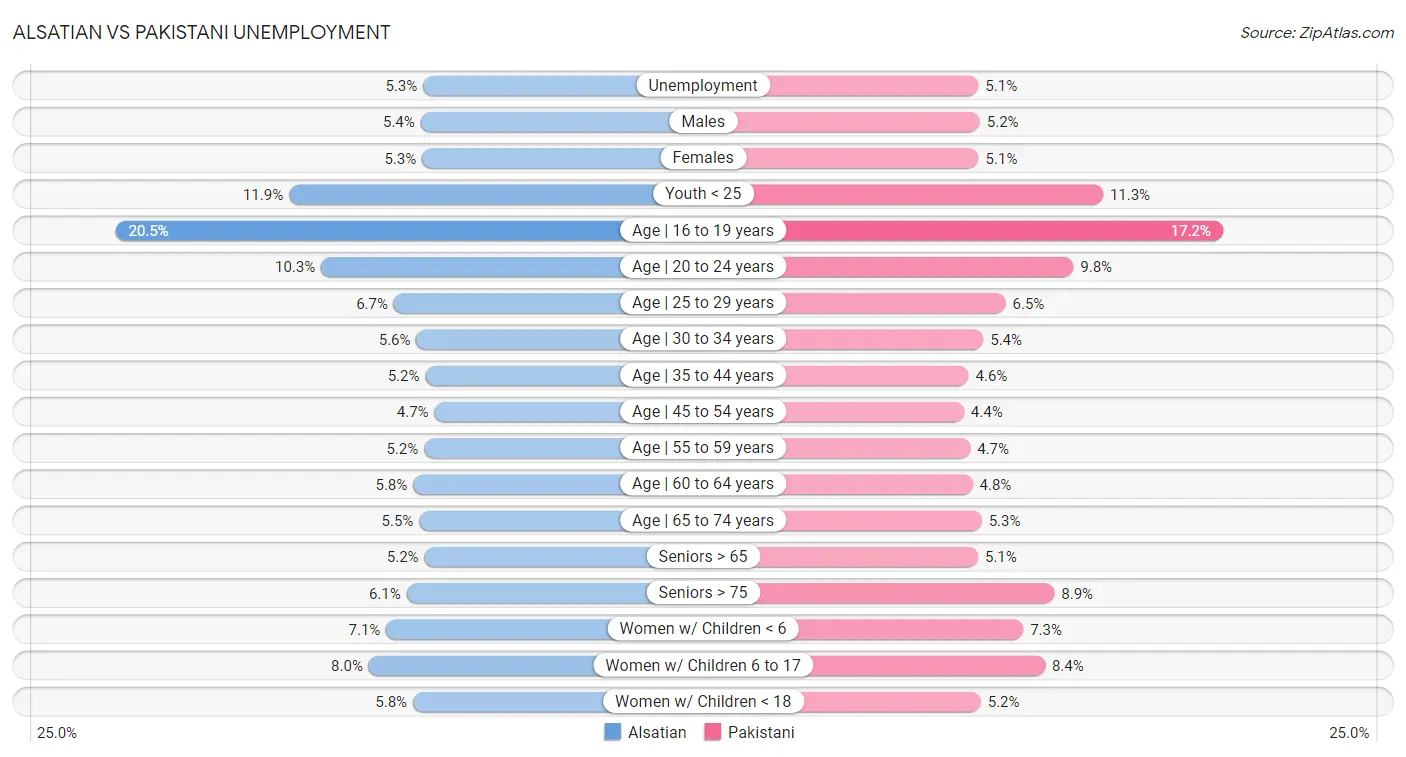
| Unemployment Metric | Alsatian | Pakistani |
| Unemployment | Fair 5.3% | Excellent 5.1% |
| Males | Poor 5.4% | Excellent 5.2% |
| Females | Fair 5.3% | Excellent 5.1% |
| Youth < 25 | Tragic 11.9% | Exceptional 11.3% |
| Age | 16 to 19 years | Tragic 20.5% | Excellent 17.2% |
| Age | 20 to 24 years | Average 10.3% | Exceptional 9.8% |
| Age | 25 to 29 years | Fair 6.7% | Excellent 6.5% |
| Age | 30 to 34 years | Poor 5.6% | Good 5.4% |
| Age | 35 to 44 years | Tragic 5.2% | Good 4.6% |
| Age | 45 to 54 years | Tragic 4.7% | Exceptional 4.4% |
| Age | 55 to 59 years | Tragic 5.2% | Excellent 4.7% |
| Age | 60 to 64 years | Tragic 5.8% | Good 4.8% |
| Age | 65 to 74 years | Tragic 5.5% | Excellent 5.3% |
| Seniors > 65 | Poor 5.2% | Good 5.1% |
| Seniors > 75 | Exceptional 6.1% | Fair 8.9% |
| Women w/ Children < 6 | Exceptional 7.1% | Exceptional 7.3% |
| Women w/ Children 6 to 17 | Exceptional 8.0% | Exceptional 8.4% |
| Women w/ Children < 18 | Tragic 5.8% | Excellent 5.2% |
Alsatian vs Pakistani Labor Participation
When considering labor participation, the most significant differences between Alsatian and Pakistani communities in the United States are seen in in labor force | age 16-19 (35.9% compared to 37.6%, a difference of 4.7%), in labor force | age 45-54 (81.3% compared to 82.8%, a difference of 1.8%), and in labor force | age > 16 (64.7% compared to 65.8%, a difference of 1.6%). Conversely, both communities are more comparable in terms of in labor force | age 35-44 (84.4% compared to 84.4%, a difference of 0.050%), in labor force | age 30-34 (85.2% compared to 84.7%, a difference of 0.50%), and in labor force | age 20-64 (79.1% compared to 79.8%, a difference of 0.84%).

| Labor Participation Metric | Alsatian | Pakistani |
| In Labor Force | Age > 16 | Poor 64.7% | Exceptional 65.8% |
| In Labor Force | Age 20-64 | Tragic 79.1% | Good 79.8% |
| In Labor Force | Age 16-19 | Poor 35.9% | Excellent 37.6% |
| In Labor Force | Age 20-24 | Fair 74.8% | Exceptional 75.8% |
| In Labor Force | Age 25-29 | Tragic 83.9% | Good 84.8% |
| In Labor Force | Age 30-34 | Exceptional 85.2% | Good 84.7% |
| In Labor Force | Age 35-44 | Average 84.4% | Average 84.4% |
| In Labor Force | Age 45-54 | Tragic 81.3% | Average 82.8% |
Alsatian vs Pakistani Family Structure
When considering family structure, the most significant differences between Alsatian and Pakistani communities in the United States are seen in births to unmarried women (33.8% compared to 30.5%, a difference of 10.9%), family households with children (25.3% compared to 27.9%, a difference of 10.4%), and single father households (2.1% compared to 2.3%, a difference of 7.2%). Conversely, both communities are more comparable in terms of divorced or separated (11.9% compared to 11.9%, a difference of 0.16%), single mother households (6.2% compared to 6.1%, a difference of 1.6%), and average family size (3.14 compared to 3.22, a difference of 2.5%).

| Family Structure Metric | Alsatian | Pakistani |
| Family Households | Tragic 61.7% | Excellent 64.7% |
| Family Households with Children | Tragic 25.3% | Exceptional 27.9% |
| Married-couple Households | Tragic 44.8% | Excellent 47.3% |
| Average Family Size | Tragic 3.14 | Fair 3.22 |
| Single Father Households | Exceptional 2.1% | Good 2.3% |
| Single Mother Households | Good 6.2% | Good 6.1% |
| Currently Married | Poor 45.7% | Good 47.2% |
| Divorced or Separated | Excellent 11.9% | Excellent 11.9% |
| Births to Unmarried Women | Tragic 33.8% | Excellent 30.5% |
Alsatian vs Pakistani Vehicle Availability
When considering vehicle availability, the most significant differences between Alsatian and Pakistani communities in the United States are seen in no vehicles in household (13.2% compared to 9.0%, a difference of 46.6%), 4 or more vehicles in household (5.4% compared to 7.0%, a difference of 29.7%), and 3 or more vehicles in household (18.0% compared to 21.0%, a difference of 17.1%). Conversely, both communities are more comparable in terms of 1 or more vehicles in household (87.1% compared to 91.3%, a difference of 4.8%), 2 or more vehicles in household (52.5% compared to 57.9%, a difference of 10.3%), and 3 or more vehicles in household (18.0% compared to 21.0%, a difference of 17.1%).

| Vehicle Availability Metric | Alsatian | Pakistani |
| No Vehicles Available | Tragic 13.2% | Exceptional 9.0% |
| 1+ Vehicles Available | Tragic 87.1% | Exceptional 91.3% |
| 2+ Vehicles Available | Tragic 52.5% | Exceptional 57.9% |
| 3+ Vehicles Available | Tragic 18.0% | Exceptional 21.0% |
| 4+ Vehicles Available | Tragic 5.4% | Exceptional 7.0% |
Alsatian vs Pakistani Education Level
When considering education level, the most significant differences between Alsatian and Pakistani communities in the United States are seen in professional degree (5.2% compared to 4.8%, a difference of 9.1%), master's degree (16.9% compared to 15.8%, a difference of 6.9%), and no schooling completed (2.0% compared to 2.1%, a difference of 5.4%). Conversely, both communities are more comparable in terms of 9th grade (94.9% compared to 95.0%, a difference of 0.040%), 8th grade (95.8% compared to 95.7%, a difference of 0.080%), and 10th grade (93.8% compared to 93.9%, a difference of 0.10%).
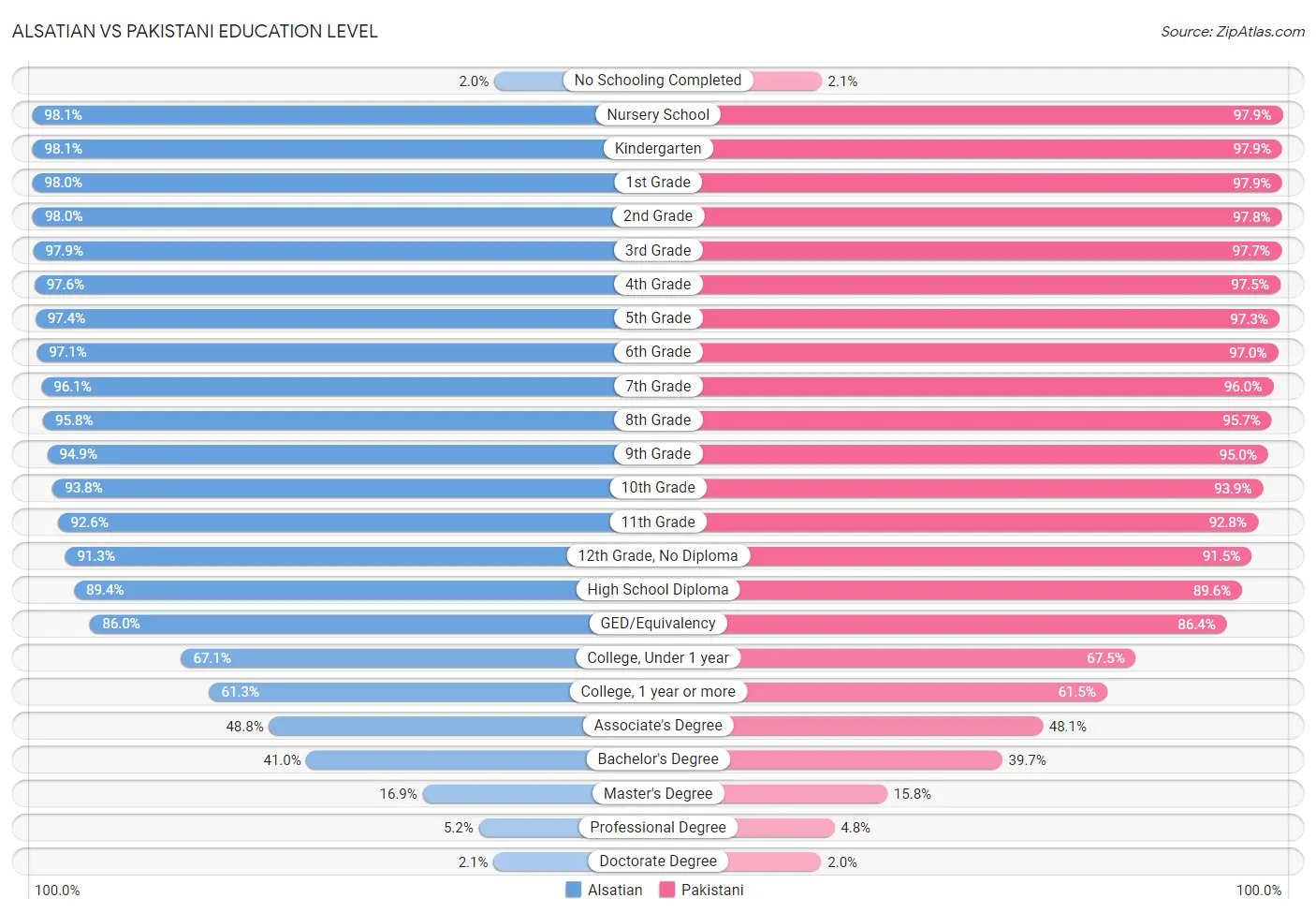
| Education Level Metric | Alsatian | Pakistani |
| No Schooling Completed | Good 2.0% | Average 2.1% |
| Nursery School | Excellent 98.1% | Fair 97.9% |
| Kindergarten | Excellent 98.1% | Fair 97.9% |
| 1st Grade | Excellent 98.0% | Fair 97.9% |
| 2nd Grade | Excellent 98.0% | Fair 97.8% |
| 3rd Grade | Good 97.9% | Fair 97.7% |
| 4th Grade | Good 97.6% | Fair 97.5% |
| 5th Grade | Good 97.4% | Average 97.3% |
| 6th Grade | Good 97.1% | Average 97.0% |
| 7th Grade | Good 96.1% | Average 96.0% |
| 8th Grade | Good 95.8% | Average 95.7% |
| 9th Grade | Average 94.9% | Good 95.0% |
| 10th Grade | Average 93.8% | Good 93.9% |
| 11th Grade | Good 92.6% | Good 92.8% |
| 12th Grade, No Diploma | Average 91.3% | Good 91.5% |
| High School Diploma | Good 89.4% | Good 89.6% |
| GED/Equivalency | Good 86.0% | Excellent 86.4% |
| College, Under 1 year | Exceptional 67.1% | Exceptional 67.5% |
| College, 1 year or more | Exceptional 61.3% | Exceptional 61.5% |
| Associate's Degree | Exceptional 48.8% | Excellent 48.1% |
| Bachelor's Degree | Exceptional 41.0% | Excellent 39.7% |
| Master's Degree | Exceptional 16.9% | Excellent 15.8% |
| Professional Degree | Exceptional 5.2% | Exceptional 4.8% |
| Doctorate Degree | Exceptional 2.1% | Exceptional 2.0% |
Alsatian vs Pakistani Disability
When considering disability, the most significant differences between Alsatian and Pakistani communities in the United States are seen in vision disability (2.3% compared to 2.1%, a difference of 9.7%), disability age under 5 (1.2% compared to 1.3%, a difference of 6.5%), and disability age 35 to 64 (11.8% compared to 11.1%, a difference of 6.2%). Conversely, both communities are more comparable in terms of disability age over 75 (47.3% compared to 47.7%, a difference of 0.71%), hearing disability (3.1% compared to 3.1%, a difference of 0.93%), and cognitive disability (17.7% compared to 17.3%, a difference of 2.0%).
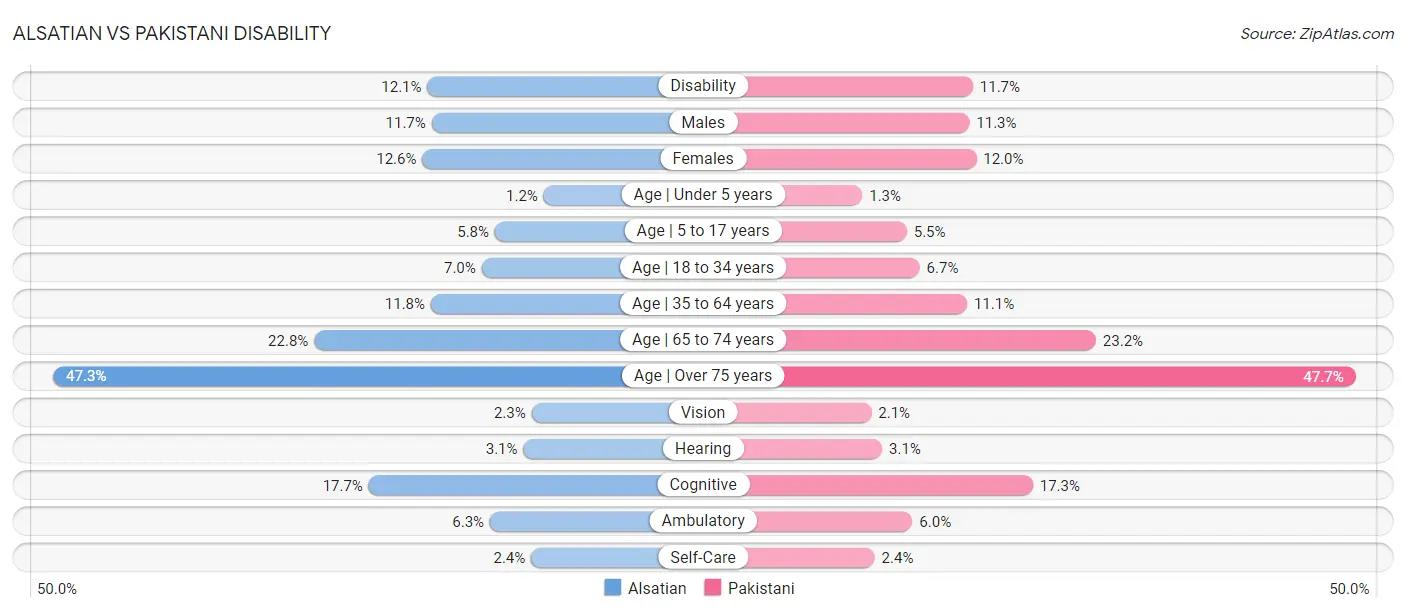
| Disability Metric | Alsatian | Pakistani |
| Disability | Tragic 12.1% | Average 11.7% |
| Males | Tragic 11.7% | Fair 11.3% |
| Females | Tragic 12.6% | Excellent 12.0% |
| Age | Under 5 years | Good 1.2% | Poor 1.3% |
| Age | 5 to 17 years | Tragic 5.8% | Excellent 5.5% |
| Age | 18 to 34 years | Tragic 7.0% | Fair 6.7% |
| Age | 35 to 64 years | Tragic 11.8% | Good 11.1% |
| Age | 65 to 74 years | Excellent 22.8% | Average 23.2% |
| Age | Over 75 years | Average 47.3% | Fair 47.7% |
| Vision | Tragic 2.3% | Good 2.1% |
| Hearing | Poor 3.1% | Poor 3.1% |
| Cognitive | Tragic 17.7% | Average 17.3% |
| Ambulatory | Poor 6.3% | Excellent 6.0% |
| Self-Care | Exceptional 2.4% | Good 2.4% |